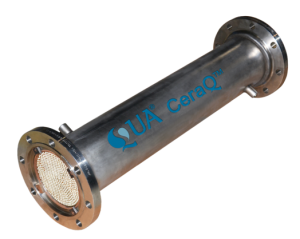Comparison of polymeric and ceramic ultrafiltration membranes 129 0 2 4 6 8 10 12 14 5 1030 1550 300 membrane cut off kda permeate flux m 3 m 2 d c pes polymeric membranes ceramic membranes fig.
Ceramic membrane vs polymeric membrane.
Mass balance analysis shows that 85 8 of the npoc is.
Distilled water flux for polymeric and ceramic membranes a similar dependence as that for distilled water was observed for all the mem.
Katie guerra p e of the bureau of reclamation reported on her efforts to put to the test the common assumptions that ceramic micro and ultrafiltration systems though more robust and forgiving have such a high capital cost that polymeric membrane systems provide a lower total operating cost advantage.
Polymeric and ceramic membranes aqua aerobic systems provides two types of aqua multibore membranes polymeric and ceramic.
To be made useful the membrane material must be formed or configured in such a way as to allow water to pass through it.
Additionally ceramic membranes are ideal for in place chemical cleaning at high temperatures while using caustic chlorine hydrogen peroxide ozone and strong inorganic acids and or by using steam sterilization.
Consequently cleaning effect on membrane fouling is lack of comparability between polymeric and ceramic membrane.
Opex l j t this means that as far as the cost effectiveness of the ceramic membrane compared with the polymeric one is concerned the determining factor is the ratio of the term l j t for the two materials.
They are generally used for highly acidic or basic environments due to inertness.
Ceramic membranes consist of metal aluminum or titanium and non metal oxides nitride or carbide.
This makes these membranes suitable for many applications where polymeric and other inorganic membranes cannot be used.
The higher degree of fouling on the polymeric membrane is partly due to its lower volume area ratio compared to ceramic membranes.
Moreover chemical cleaning efficacy on membrane fouling of polymeric membrane 24 25 and ceramic membrane 26 27 has only been studied in isolation with disparate initial fouling extent and different cleaning protocols.
A number of different polymeric and ceramic materials are used to form membranes.
The trans membrane pressure tmp increase at a constant flux of 150 l m 2 h 1 due to membrane fouling by direct filtration with lake water is investigated for four ceramic al 2 o 3 zro 2 tio 2 sic and a pes pvp polymeric microfiltration membrane s the membrane structures and compositions are characterised with permporometry pore size porosity and xps.
There are mainly two different types of membrane material.










